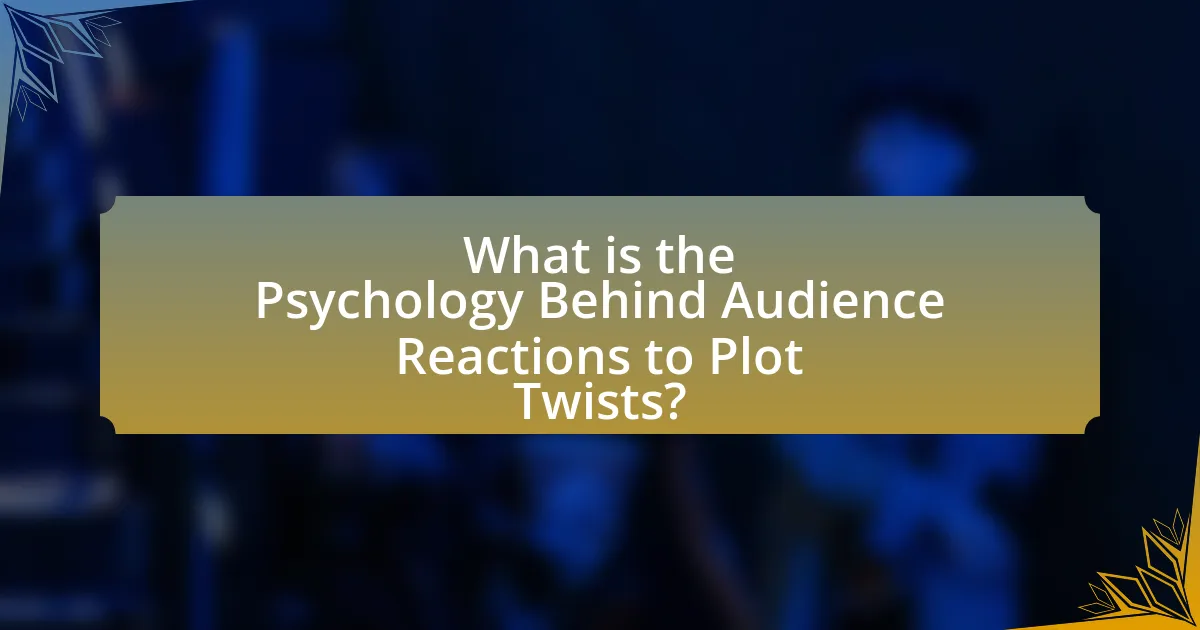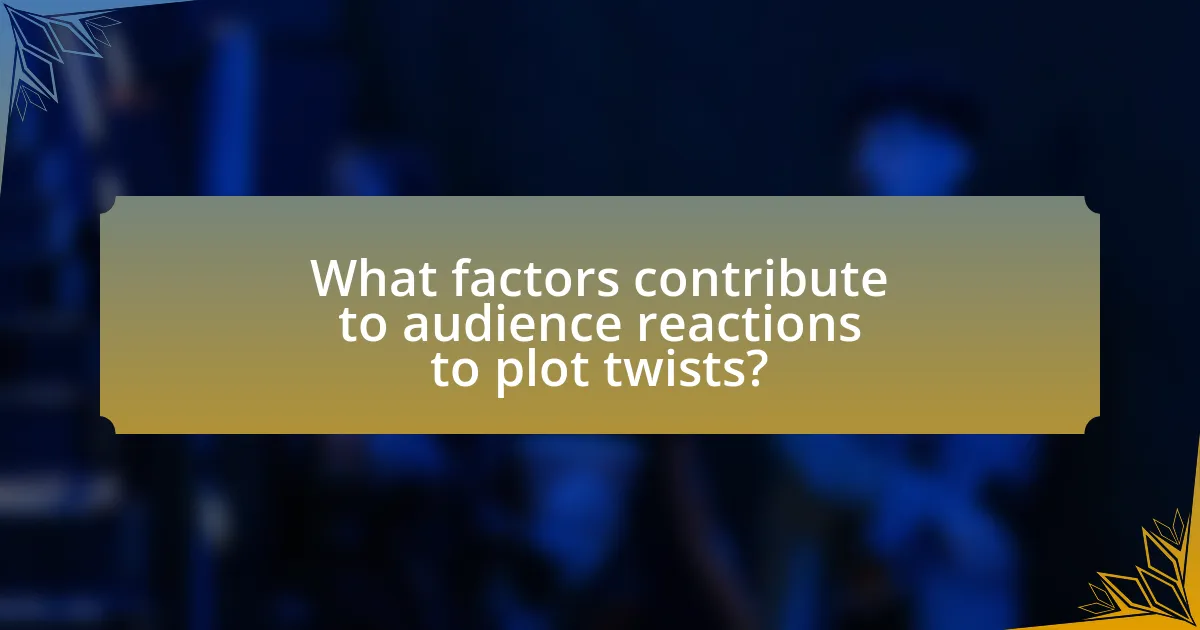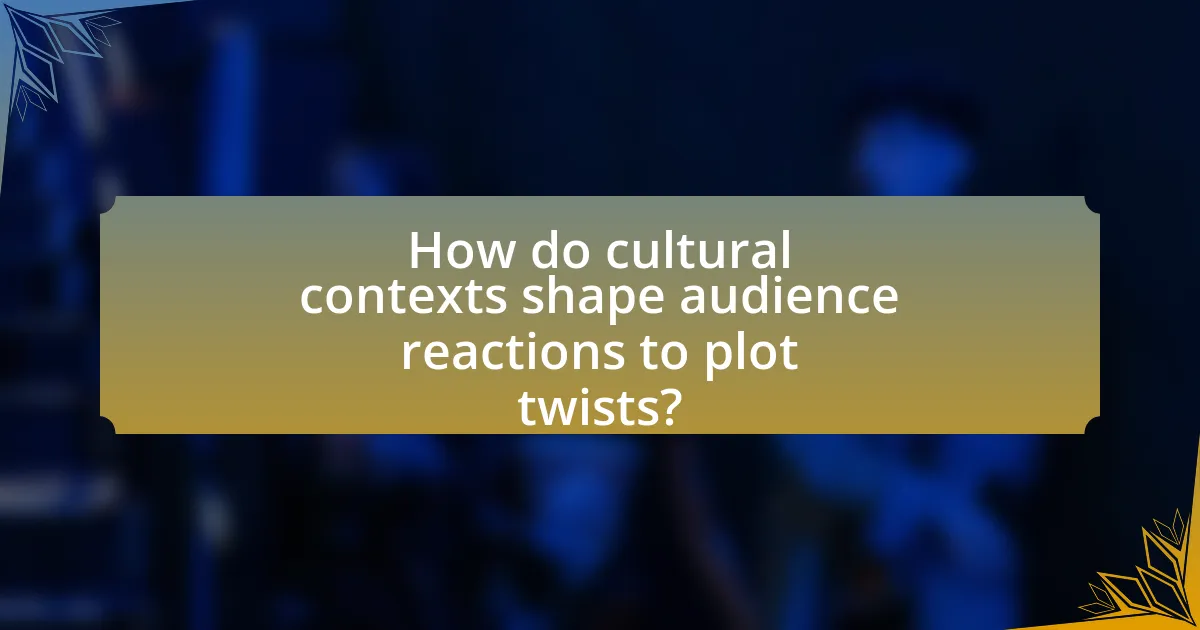The article explores the psychology behind audience reactions to plot twists, emphasizing the roles of cognitive dissonance and emotional engagement. It examines how plot twists disrupt expectations, leading to heightened emotional responses such as surprise and shock, which can enhance viewer satisfaction and narrative retention. Key psychological mechanisms activated during plot twists include cognitive dissonance, surprise, and emotional engagement, all of which contribute to a deeper connection with the story. Additionally, the article discusses how audience expectations, demographic factors, and cultural contexts shape reactions to plot twists, highlighting the significance of these elements in storytelling and narrative engagement.

What is the Psychology Behind Audience Reactions to Plot Twists?
The psychology behind audience reactions to plot twists involves cognitive dissonance and emotional engagement. When a plot twist occurs, it often contradicts the audience’s expectations, leading to a state of cognitive dissonance where viewers must reconcile their prior beliefs with the new information presented. This dissonance can heighten emotional responses, such as surprise or shock, as the brain processes the unexpected change in narrative direction. Research indicates that plot twists can enhance viewer satisfaction when they are well-executed, as they provide a sense of novelty and complexity, which engages the audience more deeply. A study by Green and Brock (2000) found that narrative transportation, where individuals become immersed in a story, can amplify emotional reactions to plot developments, including twists.
How do plot twists influence audience emotions?
Plot twists significantly influence audience emotions by eliciting surprise, shock, and re-evaluation of the narrative. These emotional responses occur because plot twists disrupt the expected storyline, prompting viewers to reassess their understanding of characters and events. Research indicates that unexpected plot developments can activate the brain’s reward system, leading to increased engagement and heightened emotional investment in the story. For instance, a study published in the journal “Psychological Science” by researchers at the University of California found that unexpected narrative turns enhance emotional arousal and memory retention, demonstrating the profound impact of plot twists on audience emotions.
What psychological mechanisms are activated during a plot twist?
Plot twists activate several psychological mechanisms, primarily cognitive dissonance, surprise, and emotional engagement. Cognitive dissonance occurs when the audience’s expectations are violated, leading to a mental conflict that prompts reevaluation of prior beliefs or assumptions. Surprise is triggered by the unexpected nature of the twist, which can heighten attention and engagement, as evidenced by studies showing that unexpected events capture cognitive resources more effectively. Emotional engagement intensifies as viewers experience a range of feelings, from shock to excitement, which can enhance memory retention of the narrative. These mechanisms collectively contribute to a deeper connection with the story and its characters, reinforcing the impact of the plot twist on the audience’s overall experience.
How do audience expectations shape their reactions to plot twists?
Audience expectations significantly influence their reactions to plot twists by creating a framework through which they interpret narrative developments. When viewers anticipate certain outcomes based on established narrative cues, their emotional responses to unexpected twists can range from surprise to disappointment. Research indicates that when a plot twist aligns with or subverts these expectations, it can enhance engagement or lead to dissatisfaction, respectively. For instance, a study published in the journal “Psychology of Aesthetics, Creativity, and the Arts” by authors such as M. A. Green and J. Garst found that unexpected plot developments that still resonate with the audience’s prior knowledge can lead to a more profound emotional impact. Thus, audience expectations serve as a critical lens that shapes their overall experience and interpretation of plot twists.
Why are plot twists significant in storytelling?
Plot twists are significant in storytelling because they create surprise and challenge audience expectations, enhancing emotional engagement. When a narrative takes an unexpected turn, it stimulates cognitive processing, prompting viewers to reevaluate the story and its characters. Research indicates that plot twists can increase viewer satisfaction and retention, as they often lead to a more profound understanding of the narrative’s themes and character motivations. For example, a study published in the journal “Psychological Science” by researchers at the University of California found that unexpected plot developments can lead to heightened emotional responses, making the story more memorable.
What role do plot twists play in narrative engagement?
Plot twists significantly enhance narrative engagement by creating surprise and altering audience expectations. These unexpected developments stimulate emotional responses, such as shock or excitement, which can lead to a deeper investment in the story. Research indicates that plot twists activate the brain’s reward system, increasing dopamine levels, which heightens enjoyment and retention of the narrative. For instance, a study published in the journal “Cognitive Science” by researchers at the University of California found that unexpected plot developments lead to increased engagement and memory recall among viewers. This demonstrates that plot twists are not merely narrative devices but essential elements that foster a more immersive and memorable storytelling experience.
How do plot twists affect audience retention and recall of the story?
Plot twists significantly enhance audience retention and recall of a story by creating surprise and emotional engagement. Research indicates that unexpected narrative developments activate the brain’s reward system, leading to increased attention and memory consolidation. For instance, a study published in the journal “Cognitive Science” by researchers at the University of California found that participants who experienced plot twists demonstrated better recall of story details compared to those who encountered predictable narratives. This heightened engagement results from the cognitive dissonance created by the twist, prompting audiences to reevaluate the story and solidify their understanding of the plot.

What factors contribute to audience reactions to plot twists?
Audience reactions to plot twists are influenced by factors such as narrative structure, emotional investment, and cognitive engagement. Narrative structure plays a crucial role, as well-crafted twists that align with the story’s foreshadowing can enhance surprise and satisfaction. Emotional investment is significant; viewers who are deeply connected to characters are more likely to experience intense reactions to unexpected developments. Cognitive engagement, including the audience’s ability to predict outcomes and process information, also affects reactions; twists that challenge expectations can lead to heightened emotional responses. Research indicates that well-executed plot twists can evoke strong emotional reactions, as seen in studies analyzing viewer engagement and satisfaction levels in response to narrative surprises.
How does genre influence audience expectations of plot twists?
Genre significantly influences audience expectations of plot twists by establishing specific narrative conventions and tropes that viewers anticipate. For instance, in mystery genres, audiences expect unexpected revelations that challenge their assumptions, while in romantic comedies, plot twists often revolve around misunderstandings that lead to humorous resolutions. Research indicates that genre familiarity shapes cognitive processing, as viewers utilize prior knowledge to predict outcomes, thereby enhancing their engagement with the narrative. This expectation is supported by studies showing that audiences are more likely to appreciate plot twists that align with genre-specific norms, as they create a satisfying cognitive dissonance when executed effectively.
What are the common characteristics of plot twists in different genres?
Common characteristics of plot twists across different genres include unexpected revelations, subversion of audience expectations, and the integration of foreshadowing elements. Unexpected revelations often serve to surprise the audience, creating a moment of shock or realization that alters the narrative’s direction. Subversion of audience expectations is crucial, as it challenges preconceived notions established earlier in the story, leading to a more engaging experience. Additionally, effective plot twists frequently incorporate foreshadowing, where subtle hints are embedded within the narrative, allowing for a retrospective understanding that enhances the twist’s impact. These characteristics are evident in various genres, from thrillers to romances, demonstrating their universal appeal and effectiveness in storytelling.
How do audience demographics affect their perception of plot twists?
Audience demographics significantly influence their perception of plot twists, as factors such as age, cultural background, and gender shape individual expectations and interpretations. For instance, younger audiences may be more accustomed to rapid storytelling and unexpected turns due to exposure to diverse media, leading them to appreciate complex twists more than older viewers, who might prefer traditional narrative structures. Additionally, cultural background plays a crucial role; studies indicate that individuals from collectivist cultures may interpret plot twists through a lens of community and relational dynamics, while those from individualistic cultures might focus on personal agency and character development. Gender differences also emerge, with research showing that women may respond more emotionally to plot twists that involve relational conflicts, whereas men might favor twists that emphasize action or strategic deception. These demographic factors collectively shape how audiences engage with and evaluate the effectiveness of plot twists in narratives.
What cognitive biases impact audience reactions to plot twists?
Cognitive biases that impact audience reactions to plot twists include confirmation bias, the anchoring effect, and the surprise bias. Confirmation bias leads audiences to favor information that confirms their pre-existing beliefs or theories about the plot, often causing them to overlook clues that foreshadow the twist. The anchoring effect causes viewers to rely heavily on the initial information presented in the story, which can skew their interpretation of subsequent developments. Surprise bias refers to the tendency of audiences to react more strongly to unexpected twists, which can enhance emotional engagement but may also lead to negative reactions if the twist feels unearned or implausible. These biases shape how audiences process narrative information and respond to unexpected changes in the storyline.
How does confirmation bias affect the interpretation of plot twists?
Confirmation bias significantly influences the interpretation of plot twists by leading audiences to favor information that aligns with their pre-existing beliefs or expectations. When viewers have a specific theory about a narrative, they are more likely to interpret ambiguous plot elements in a way that confirms their assumptions, often overlooking contradictory evidence. Research indicates that this cognitive bias can result in a skewed understanding of the story, as individuals may dismiss or rationalize details that do not fit their narrative expectations. For instance, a study published in the journal “Cognitive Science” by researchers at the University of California found that participants who held strong expectations about a story’s outcome were less likely to recognize plot inconsistencies, demonstrating how confirmation bias can distort narrative comprehension.
What is the role of surprise and its psychological effects on audiences?
Surprise plays a crucial role in engaging audiences by eliciting strong emotional responses and enhancing memory retention. When audiences encounter unexpected events, such as plot twists, their brains release dopamine, which heightens attention and emotional engagement. Research indicates that surprise can lead to increased enjoyment and satisfaction with narratives, as it challenges expectations and stimulates curiosity. For instance, a study published in the journal “Cognitive Science” by researchers at the University of California found that unexpected plot developments significantly improved recall of story details, demonstrating that surprise not only captivates but also reinforces memory.

How do cultural contexts shape audience reactions to plot twists?
Cultural contexts significantly shape audience reactions to plot twists by influencing their expectations, values, and emotional responses. For instance, in collectivist cultures, where group harmony is prioritized, plot twists that disrupt social relationships may elicit stronger negative reactions compared to individualistic cultures, where personal achievement is emphasized. Research by Tsai et al. (2006) in “Cultural Differences in Emotional Responses” highlights that individuals from different cultural backgrounds interpret emotional cues differently, affecting their engagement with narrative surprises. Additionally, cultural narratives and folklore can set specific expectations for storytelling, leading audiences to react more favorably or unfavorably to twists that align or conflict with these established norms.
What cultural factors influence the effectiveness of plot twists?
Cultural factors significantly influence the effectiveness of plot twists by shaping audience expectations and interpretations. Different cultures have varying storytelling traditions, which affect how plot developments are perceived; for instance, Western narratives often emphasize individualism and surprise, while Eastern narratives may focus on collective experiences and subtlety. Research indicates that cultural context can dictate the emotional responses elicited by plot twists, as seen in studies where audiences from collectivist cultures reacted more favorably to twists that reinforced group dynamics, while individualistic cultures preferred twists that highlighted personal agency. This demonstrates that cultural background not only frames the narrative structure but also informs the emotional resonance of plot twists, ultimately affecting their impact on the audience.
How do cultural narratives and values affect audience expectations?
Cultural narratives and values significantly shape audience expectations by establishing a framework through which stories are interpreted. These narratives dictate what is considered acceptable, relatable, or engaging within a specific cultural context, influencing how audiences anticipate plot developments. For instance, in Western cultures, narratives often emphasize individualism and personal growth, leading audiences to expect character arcs that reflect these values. Conversely, in collectivist cultures, narratives may prioritize community and familial ties, shaping expectations around group dynamics and resolutions. Research indicates that cultural context can alter emotional responses to plot twists; for example, a study published in the Journal of Cross-Cultural Psychology found that audiences from individualistic cultures reacted more positively to unexpected individual triumphs, while collectivist audiences preferred outcomes that reinforced social harmony. This demonstrates that cultural narratives and values are crucial in forming the lens through which audiences engage with and interpret stories.
What examples illustrate cultural differences in reactions to plot twists?
Cultural differences significantly influence reactions to plot twists, as evidenced by varying audience responses in different regions. For instance, in Western cultures, viewers often express shock or disbelief when confronted with unexpected plot twists, as seen in films like “The Sixth Sense,” where the twist is met with gasps and discussions about its implications. Conversely, in East Asian cultures, such as Japan, audiences may react with a more subdued acceptance, reflecting a cultural tendency towards harmony and less overt emotional expression, as illustrated by the film “Oldboy,” where the twist is integrated into the narrative without dramatic emphasis. These differences highlight how cultural contexts shape emotional responses and interpretations of narrative surprises.
How do social dynamics impact audience reactions to plot twists?
Social dynamics significantly influence audience reactions to plot twists by shaping expectations and emotional responses. When viewers share social contexts, such as cultural backgrounds or group identities, these factors can create a collective anticipation or skepticism towards narrative developments. For instance, research indicates that audiences from collectivist cultures may react more positively to plot twists that emphasize community and relationships, while individualistic cultures might favor twists that highlight personal achievement or conflict. Additionally, social dynamics can affect how audiences interpret the motivations behind characters’ actions, leading to varied emotional responses based on group norms and values. This interplay between social context and narrative structure underscores the importance of audience demographics in shaping the reception of plot twists.
What is the role of group dynamics in experiencing plot twists?
Group dynamics significantly influence how audiences experience plot twists by shaping collective emotional responses and interpretations. When individuals watch a narrative together, their reactions can be amplified or moderated by the group’s shared emotional state, leading to a heightened sense of surprise or disbelief during plot twists. Research indicates that social validation within a group can enhance the impact of unexpected narrative developments, as individuals often look to others for cues on how to react. For instance, a study published in the Journal of Experimental Social Psychology found that participants who viewed a film in groups reported stronger emotional reactions to plot twists compared to those who watched alone, demonstrating the power of social context in shaping audience experiences.
How do discussions and social media influence audience perceptions of plot twists?
Discussions and social media significantly shape audience perceptions of plot twists by facilitating the exchange of interpretations and reactions. When viewers engage in conversations online, they share insights and theories that can alter individual understandings of a narrative. For instance, a study published in the journal “Communication Research” by authors Sarah J. Tracy and Jennifer L. Monahan found that social media discussions can amplify emotional responses to plot twists, as audiences often validate their feelings through communal dialogue. This collective engagement can lead to a consensus that influences how plot twists are perceived, making them more impactful or altering their significance based on shared interpretations.
What practical insights can be drawn from understanding audience reactions to plot twists?
Understanding audience reactions to plot twists reveals that emotional engagement significantly influences viewer satisfaction and retention. Research indicates that unexpected plot developments can enhance the overall experience, as they evoke strong emotional responses, leading to increased discussion and sharing among audiences. For instance, a study published in the journal “Psychology of Popular Media” by Green and Brock (2000) found that narrative transportation, which occurs when audiences become immersed in a story, is heightened by surprising twists. This immersion fosters a deeper connection to the narrative and characters, ultimately enhancing viewer loyalty and encouraging repeat viewings. Therefore, creators can leverage this insight to craft more compelling narratives that resonate with audiences, ensuring that plot twists are not only surprising but also emotionally impactful.
How can writers effectively craft plot twists to enhance audience engagement?
Writers can effectively craft plot twists by establishing a strong foundation of foreshadowing and misdirection, which keeps the audience engaged and surprised. By subtly hinting at future events without revealing their true significance, writers create an expectation that can be subverted later, enhancing the impact of the twist. Research indicates that well-executed plot twists can evoke strong emotional responses, as they challenge the audience’s assumptions and encourage deeper engagement with the narrative. For instance, a study published in the journal “Psychology of Aesthetics, Creativity, and the Arts” found that unexpected plot developments can lead to increased enjoyment and satisfaction among viewers, as they feel rewarded for their investment in the story.
What strategies can be employed to anticipate audience reactions to plot twists?
To anticipate audience reactions to plot twists, creators can employ strategies such as audience testing, analyzing genre conventions, and utilizing psychological principles. Audience testing involves screening early versions of the content to gauge reactions, allowing creators to adjust the plot twist based on feedback. Analyzing genre conventions helps in understanding audience expectations; for instance, thrillers often have twists that challenge the protagonist’s assumptions, which can be anticipated by familiarizing oneself with common tropes. Utilizing psychological principles, such as the concept of cognitive dissonance, can also inform how audiences might react when faced with unexpected plot developments, as they seek to reconcile conflicting information. These strategies are supported by research indicating that audience engagement and emotional responses can be predicted through systematic analysis of viewer behavior and preferences.


